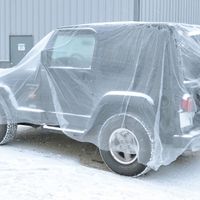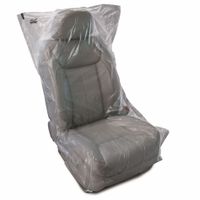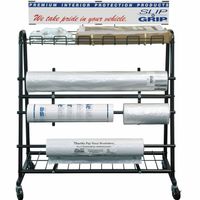Call +(254) 703 030 000 / 751 483 999 / 721 704 777
- Home
- Fleet Vehicle Maintenance
- Garage Equipment
- Vehicle Protection Covers
Vehicle Protection Covers
Vehicle covers protect entire vehicles or parts from dust, dirt, and damage during storage or transport. Exterior covers safeguard vehicles against bad weather and debris, keeping them clean and dry. Interior covers keep dust, dirt, and airborne contaminants from settling on seats and surfaces. Read Less
Frequently Asked Questions
What are the benefits of using a vehicle cover?
Using a vehicle cover offers several benefits:
1. **Protection from Weather Elements**: Vehicle covers shield cars from harsh weather conditions such as rain, snow, and hail, preventing rust and corrosion. They also protect against UV rays, which can fade paint and damage interiors.
2. **Dust and Dirt Prevention**: Covers keep dust, dirt, and debris from settling on the vehicle, maintaining its cleanliness and reducing the frequency of washes.
3. **Scratch and Dent Protection**: Covers provide a physical barrier against minor scratches, dings, and dents from accidental bumps or falling objects.
4. **Theft Deterrence**: A covered vehicle is less visible and may deter thieves, as it takes more effort to remove the cover and access the car.
5. **Preservation of Interior**: By blocking sunlight, covers help prevent the interior from fading and cracking, preserving the dashboard, seats, and other components.
6. **Animal Protection**: Covers can deter animals from nesting or leaving droppings on the vehicle, which can cause damage or require cleaning.
7. **Cost-Effective Maintenance**: By reducing the need for frequent cleaning and repairs, covers can save money on maintenance and extend the vehicle's lifespan.
8. **Convenience**: Covers are easy to use and can be quickly applied or removed, providing a convenient way to protect the vehicle when not in use.
9. **Resale Value**: Maintaining the vehicle's exterior and interior condition with a cover can help retain its resale value by keeping it in better shape over time.
10. **Customization and Fit**: Many covers are available in custom fits for specific models, ensuring comprehensive protection and a snug fit that stays in place.
Overall, vehicle covers are a practical investment for preserving a car's appearance and functionality.
How do I choose the right size vehicle cover?
To choose the right size vehicle cover, follow these steps:
1. **Measure Your Vehicle**: Start by measuring the length, width, and height of your vehicle. Use a tape measure to get accurate dimensions. Note the overall length from bumper to bumper, the width at the widest point, and the height from the ground to the highest point.
2. **Consider Vehicle Type**: Different vehicle types (sedans, SUVs, trucks, motorcycles) have specific cover designs. Ensure you select a cover intended for your vehicle type to ensure a proper fit.
3. **Check Manufacturer Specifications**: Refer to your vehicle’s manual or manufacturer’s website for official dimensions. This can help verify your measurements.
4. **Select the Right Fit**: Vehicle covers come in various fits:
- **Custom-fit**: Tailored specifically for your vehicle’s make and model, offering the best protection and appearance.
- **Semi-custom**: Designed to fit a range of similar-sized vehicles, offering a balance between fit and cost.
- **Universal fit**: One-size-fits-all approach, generally less expensive but may not provide a snug fit.
5. **Account for Accessories**: If your vehicle has additional features like roof racks, spoilers, or antennas, ensure the cover accommodates these. Some covers have pockets or allowances for such accessories.
6. **Material Consideration**: Choose a material suitable for your environment. For outdoor use, consider weather-resistant materials. For indoor use, softer materials that prevent scratches are ideal.
7. **Read Reviews and Recommendations**: Check customer reviews and expert recommendations for insights on fit and durability.
8. **Return Policy**: Ensure the seller offers a return or exchange policy in case the cover doesn’t fit as expected.
By following these steps, you can select a vehicle cover that provides optimal protection and fits your vehicle perfectly.
Are there different types of vehicle covers for indoor and outdoor use?
Yes, there are different types of vehicle covers designed specifically for indoor and outdoor use.
Indoor vehicle covers are typically made from soft, breathable materials like cotton or polyester blends. These covers are designed to protect vehicles from dust, dirt, and minor scratches while stored in garages or other indoor environments. They often have a snug fit to prevent dust accumulation and are gentle on the vehicle's paint.
Outdoor vehicle covers, on the other hand, are constructed from more durable, weather-resistant materials such as polypropylene, polyester, or a combination of multiple layers. These covers are designed to withstand harsh weather conditions, including rain, snow, UV rays, and bird droppings. They often feature water-resistant or waterproof coatings and UV protection to prevent paint fading. Outdoor covers may also have reinforced seams and elastic hems to ensure a secure fit against wind and other elements.
Some vehicle covers are designed for both indoor and outdoor use, offering a balance of softness and durability. These all-weather covers typically incorporate features from both types, such as breathable yet water-resistant materials, to provide versatile protection.
Additionally, there are specialized covers for specific needs, such as custom-fit covers tailored to the exact dimensions of a vehicle, or covers with additional padding for enhanced protection against impacts. Some covers also come with anti-theft features like lockable hems or cable locks.
In summary, the choice between indoor and outdoor vehicle covers depends on the storage environment and the level of protection required.
How do I properly install a vehicle cover?
1. **Choose the Right Cover**: Ensure the cover is designed for your specific vehicle make and model for a snug fit.
2. **Clean the Vehicle**: Wash and dry your vehicle to prevent dirt and debris from scratching the paint under the cover.
3. **Unpack the Cover**: Unfold the cover and identify the front and rear. Most covers have labels or tags indicating the front.
4. **Position the Cover**: Start by placing the cover over the front of the vehicle, aligning it with the mirrors and front bumper.
5. **Secure the Front**: Pull the cover over the front bumper, ensuring it fits snugly around the edges.
6. **Drape Over the Vehicle**: Gradually pull the cover over the top of the vehicle, moving towards the rear. Ensure it covers the roof, windows, and sides evenly.
7. **Secure the Rear**: Pull the cover over the rear bumper, ensuring it fits snugly around the edges.
8. **Adjust the Sides**: Walk around the vehicle, adjusting the cover to ensure it is centered and covers the sides completely.
9. **Fasten Straps or Cords**: If the cover has straps, cords, or elastic hems, use them to secure the cover under the vehicle. This prevents it from being blown off by the wind.
10. **Check Fit and Adjust**: Ensure the cover is taut and fits well without any loose areas. Adjust as necessary for a snug fit.
11. **Lock if Necessary**: If your cover has a locking mechanism, use it to secure the cover and prevent theft.
12. **Regular Checks**: Periodically check the cover to ensure it remains secure and adjust as needed.
Can vehicle covers protect against hail and severe weather?
Vehicle covers can offer a degree of protection against hail and severe weather, but their effectiveness varies based on the cover's material and design. Standard vehicle covers, typically made from lightweight materials, primarily protect against dust, UV rays, and minor scratches. However, they may not provide sufficient protection against the impact of hailstones, especially larger ones.
For hail protection, specialized covers are available. These are often made from thicker, padded materials like multi-layered polyester or PVC, sometimes with foam or air pockets designed to absorb impact. Such covers can mitigate damage from small to medium-sized hailstones by cushioning the vehicle's surface. However, in cases of severe weather with large hailstones, even these covers might not fully prevent dents or damage.
In addition to hail, severe weather can include strong winds, heavy rain, and flying debris. A well-secured cover can protect against rain and minor debris, but in high winds, covers can become loose or even cause damage if they flap against the vehicle. Some covers come with additional straps or anchoring systems to enhance stability during storms.
Ultimately, while vehicle covers can reduce the risk of damage from hail and severe weather, they are not foolproof. For maximum protection, especially in areas prone to severe weather, parking in a garage or under a carport is advisable. In the absence of such options, investing in a high-quality, impact-resistant cover and ensuring it is properly secured can offer a reasonable level of protection.
How do I clean and maintain a vehicle cover?
To clean and maintain a vehicle cover, follow these steps:
1. **Preparation**: Remove the cover from the vehicle and shake off loose dirt and debris. Choose a clean, flat surface like a driveway or lawn to spread it out.
2. **Spot Cleaning**: For small stains, use a soft cloth or sponge with mild soap and water. Gently scrub the affected areas, then rinse thoroughly.
3. **Machine Washing**: If the cover is machine washable, use a large commercial washing machine. Set it to a gentle cycle with cold water and a mild detergent. Avoid fabric softeners and bleach, as they can damage the material.
4. **Hand Washing**: For non-machine washable covers, fill a large tub or container with cold water and mild detergent. Submerge the cover and gently agitate it by hand. Rinse thoroughly with clean water to remove all soap residues.
5. **Drying**: Air dry the cover by hanging it on a clothesline or laying it flat on a clean surface. Avoid using a dryer, as high heat can shrink or damage the fabric.
6. **Storage**: Once completely dry, fold the cover neatly and store it in a cool, dry place. Use a storage bag if available to protect it from dust and moisture.
7. **Regular Maintenance**: Regularly inspect the cover for tears or damage. Repair small tears with fabric repair tape or patches to prevent them from worsening.
8. **Avoid Harsh Conditions**: Keep the cover away from sharp objects and extreme weather conditions when not in use to prolong its lifespan.
By following these steps, you can ensure your vehicle cover remains clean and in good condition, providing effective protection for your vehicle.
Are vehicle covers waterproof or water-resistant?
Vehicle covers can be either waterproof or water-resistant, depending on the material and design.
Waterproof vehicle covers are made from materials that completely block water from penetrating through the fabric. These covers are typically constructed using synthetic materials like polyester or nylon with a waterproof coating such as polyurethane or PVC. They are designed to protect vehicles from heavy rain, snow, and other forms of moisture, ensuring that no water reaches the vehicle's surface. However, while they offer excellent protection against water, they may not be as breathable, which can lead to condensation build-up underneath the cover if not properly ventilated.
On the other hand, water-resistant vehicle covers are designed to repel water to a certain extent but are not completely impervious to it. These covers are often made from materials like cotton or polyester blends that have been treated with a water-repellent finish. They can handle light rain and moisture but may allow water to seep through during heavy or prolonged exposure. Water-resistant covers are generally more breathable than waterproof ones, reducing the risk of condensation and allowing moisture to evaporate more easily.
When choosing between waterproof and water-resistant vehicle covers, consider the climate and weather conditions in your area, as well as the level of protection you need. Waterproof covers are ideal for areas with frequent heavy rainfall or snow, while water-resistant covers may suffice in drier climates or for short-term protection.


